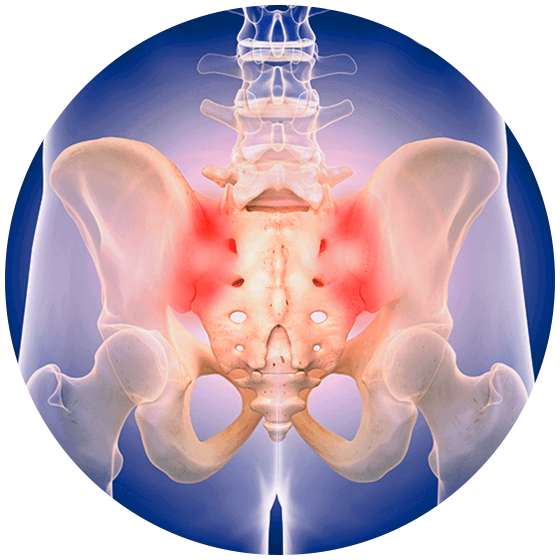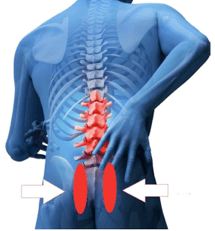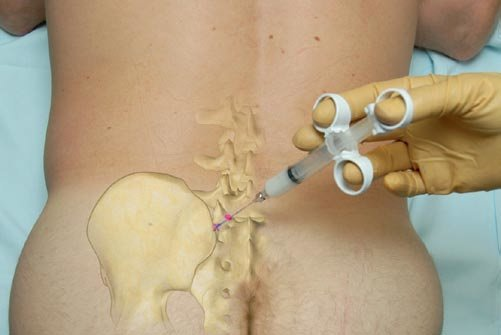Mitigate Pain Clinic – Dr Jeshnu Tople – Pain Management Specialist In Nagpur
Sacroiliac Joint Injection and RFA for Back Pain
Sacroiliac Joint Injection and Radiofrequency Ablation - Advanced Interventional Treatment for Back Pain
At Mitigate Pain Clinic, we specialize in interventional pain management techniques designed to alleviate chronic pain and enhance our patients’ quality of life.
We specialize in low back pain management; sacroiliac (SI) joint arthropathy is a common source of lower back pain. When conservative treatment options fail, the most effective treatments for this condition are sacroiliac joint injection and radiofrequency ablation (RFA).
Understanding the Sacroiliac Joint
The sacroiliac joints are located at the base of the spine. The connection where the very bottom of your spine meets hip bones on either side are called sacroiliac (SI) joints; i.e. connection of the sacrum to the iliac bones of the pelvis.
These joints play a crucial role in transferring weight and forces between the upper body and the legs. Dysfunction or inflammation in the SI joints can lead to significant lower back pain, buttock pain or sciatica-like symptoms.



Sacroiliac Joint Intra-Articular Injection
An intra-articular injection involves delivering medication directly into the sacroiliac joint. This procedure serves both diagnostic and therapeutic purposes.
Procedure Overview
- Preparation: The patient is positioned comfortably facing down on the operating room table. The skin over the SI joint is cleansed and numbed with a local anesthetic.
- Guided Needle Insertion: Using fluoroscopic (X-ray) or ultrasound guidance, a needle is precisely inserted into the SI joint.
- Contrast Injection: A contrast dye may be injected to confirm accurate needle placement within the joint.
- Medication Delivery: A combination of drugs is injected into the joint to reduce inflammation and alleviate pain.
Benefits of Sacroiliac Joint Injection
- Diagnostic Clarity: Significant pain relief following the injection can confirm the SI joint as the pain source.
- Therapeutic Relief: It can provide short-term to medium-term pain relief, facilitating participation in daily activities, physical therapy and rehabilitation.


Consideration for Sacroiliac Joint Injection
While many patients experience relief, the duration varies. Some may require repeat injections or radiofrequency ablation for sustained relief.
Radiofrequency Ablation for the Sacroiliac Joint
For patients who experience temporary relief from SI joint injections but have recurrence of pain, radiofrequency ablation may be recommended. This minimally invasive procedure targets the nerves transmitting pain signals from the SI joint.
Procedure Overview of SI Joint RFA
- Preparation: Similar to the injection, the area is cleansed and numbed.
- Needle Placement: Under fluoroscopic (X-ray) guidance, specialized needles are positioned near the small pain carrying nerves of the SI joint.
- Sensory Testing: Mild electrical stimulation may be used to confirm proper needle placement, you can feel it as tingling sensation.
- Lesioning: Once confirmed, radiofrequency energy is applied to create a heat lesion, disrupting the nerve’s ability to transmit pain signals.

Benefits of SI Joint RFA
- Extended Pain Relief: RFA can provide longer-lasting relief compared to injections.
- Improved Functionality: With reduced pain, patients often experience enhanced mobility and quality of life.
Considerations of SI Joint RFA
Nerve regeneration may sometimes occur over time, potentially leading to a return of symptoms. The procedure can be repeated if necessary.
Potential Risks and Side Effects
As with any medical procedure, there are potential risks, including:
- Infection: Rare but possible at the injection or ablation site.
- Bleeding: Especially in patients with bleeding disorders or those on anticoagulant therapy.
- Temporary Discomfort: Some patients may experience increased pain or discomfort immediately following the procedure, typically resolving within a few days.
Post-Procedure Care
Both the procedures are done as day-care and after either procedure, patients are usually monitored for a short period before being discharged. It’s advisable to have someone accompany you home. Post-procedure instructions may include:
- Activity Modification: Limiting strenuous activities for a short period to allow healing.
- Follow-Up Appointments: To assess the effectiveness of the treatment and determine the need for further interventions.
Conclusion
At Mitigate Pain Clinic, our goal is to provide personalized, effective pain management solutions. Sacroiliac joint injection and radiofrequency ablation are valuable tools in managing SI joint-related pain. By understanding these procedures, patients can make informed decisions in collaboration with their pain physician to achieve optimal pain relief and improved quality of life.
Frequently Asked Questions (FAQs)
Your pain physician may suspect SI joint dysfunction based on your symptoms, physical examination, and imaging studies. However, a diagnostic sacroiliac joint injection is the most definitive way to determine if your SI joint is the true pain generator. If you experience significant temporary relief from the injection, it's a strong indicator that the joint is involved.
Relief can vary. Some patients experience relief for several weeks to a few months. For others, the effect may be shorter. If the injection provides only temporary relief but confirms the SI joint as the pain source, your interventional pain physician may recommend radiofrequency ablation for longer-lasting results.
Most patients return to light activities within a day or two. Mild soreness at the site may last a few days. Full pain relief typically develops within 3-4 weeks as the targeted nerves are deactivated.
Yes, both SI joint injections and radiofrequency ablation are considered safe when performed by experienced specialists like those at Mitigate Pain Clinic. While rare, potential risks include bleeding, infection or temporary nerve irritation.
Yes. If your pain returns over time, especially after radiofrequency ablation due to nerve regeneration, the procedure can be safely repeated. Similarly, SI joint injections can also be repeated if they continue to provide therapeutic benefit.
Physical therapy is often recommended to strengthen the muscles around the SI joint and improve your posture and body mechanics. Combining these treatments often leads to better long-term outcomes and reduced risk of recurring pain.